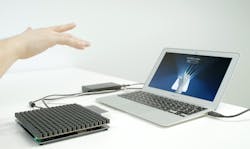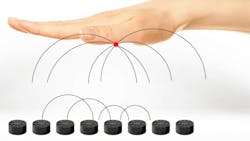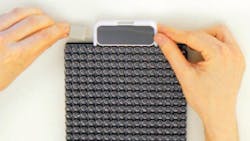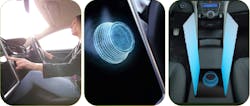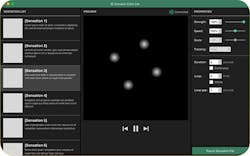Ultrasonics Brings Haptics to Augmented and Virtual Reality
Ultrahaptics hasn’t quite brought holodeck solidity to augmented or virtual reality applications, but it is a step in that direction. The company’s technology employs a phased array of ultrasonic speakers to deliver sound waves that reinforce each other, so that vibrations can be induced at a fixed position away from the array (Fig. 1). This is similar to how a phased-array radar system works.
The force on the skin of a hand is minute, but it provides sufficient haptic feedback—much like the vibrations of a smartphone when pressing a button on the screen. The difference is that the smartphone is in contact with a finger, while Ultrahaptics technology operates at a distance. The current incarnation can operate up to 2 m from a hand.
There is another aspect to this technology that is not shown in the diagram; the system needs to know where the target is located. In most cases this will be a hand or head, although it will work with most body parts when not covered by clothing. The missing piece is usually a 3D imaging system, the Leap Motion sensor used with the development kit (Fig. 2). Ultrahaptics’ technology is agnostic to the 3D imaging system.
I tried various demos recently and was suitably impressed by the feedback. For example, I could hold my hand a foot or more above an array to feel bubbles or water flowing by, and feel feedback when pressing a virtual button. The force is not sufficient to cause any significant movement or provide a solid surface (like a holodeck might), but it was more than sufficient to simulate surfaces and distinct objects.
This basic augmented reality only required the use of Ultrahaptics hardware. The hardware can also be combined with augmented or virtual reality systems. One demo had me picking up and moving small balls and blocks.
One example where the more basic approach can be effective is with automotive controls (Fig. 3) or whitegood appliances. The system can easily simulate sliders, buttons, and knobs. It can even provide positioning information so a user can know by touch whether they are close to a control or control area, without looking at the area or having other visual feedback mechanisms.
Ultrahaptics includes tools (Fig. 4) that developers can use to create different effects and touch sensations. There are other changes in the works, like a custom ultrasonic speaker that is a fraction of the size of the current automotive solution. The automotive speakers are targeted side sensors for parking and object notification versus a dense array that Ultrahaptics needs.
Long-range haptic feedback is not needed for every application, but it offers significant and unique advantages for many applications. There are many possibilities for medical applications, as well.
About the Author
William G. Wong
Senior Content Director - Electronic Design and Microwaves & RF
I am Editor of Electronic Design focusing on embedded, software, and systems. As Senior Content Director, I also manage Microwaves & RF and I work with a great team of editors to provide engineers, programmers, developers and technical managers with interesting and useful articles and videos on a regular basis. Check out our free newsletters to see the latest content.
You can send press releases for new products for possible coverage on the website. I am also interested in receiving contributed articles for publishing on our website. Use our template and send to me along with a signed release form.
Check out my blog, AltEmbedded on Electronic Design, as well as his latest articles on this site that are listed below.
You can visit my social media via these links:
- AltEmbedded on Electronic Design
- Bill Wong on Facebook
- @AltEmbedded on Twitter
- Bill Wong on LinkedIn
I earned a Bachelor of Electrical Engineering at the Georgia Institute of Technology and a Masters in Computer Science from Rutgers University. I still do a bit of programming using everything from C and C++ to Rust and Ada/SPARK. I do a bit of PHP programming for Drupal websites. I have posted a few Drupal modules.
I still get a hand on software and electronic hardware. Some of this can be found on our Kit Close-Up video series. You can also see me on many of our TechXchange Talk videos. I am interested in a range of projects from robotics to artificial intelligence.
